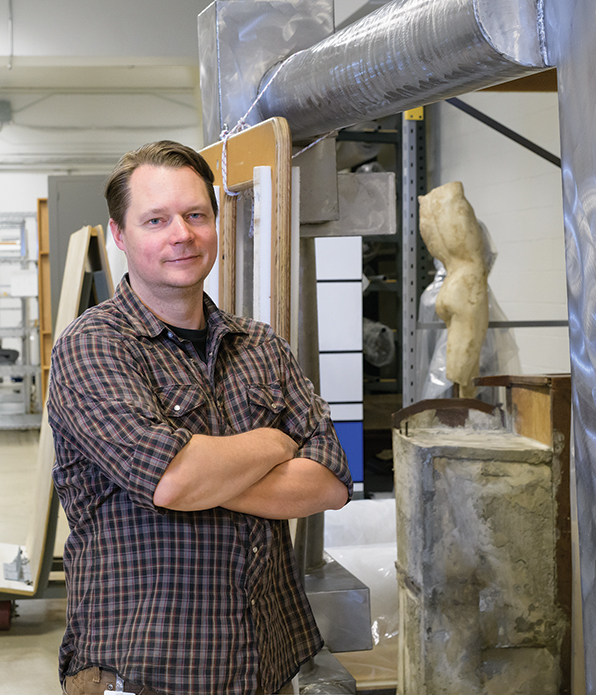You May Also Like
Reimagining Landscapes Opening up the World for Others Progress in the Pop District
Photo: Bryan Conley
When a curator wants a work of art draped across the front of the building or requests an unusually large or heavy object be moved into a gallery space, it’s Mark Blatnik and his crew of five who figure out how to make the vision a reality. With more than 32,000 artworks in his care, Carnegie Museum of Art’s chief preparator directs the safe transport, installation, and storage of the museum’s vast treasures.
Q: Are people generally familiar with your job?
A: When I tell people I’m a preparator, they often think I do taxes. Once I explain it, it can seem exotic to some people, like every day is a big adventure, and in many ways it is. I really enjoy being engaged with the fine arts, the presentation, our audiences. The educational aspect of it is what really gets me out of bed in the morning, even though my day could just be spent on a lift changing light bulbs.
Q: Do you have a typical day?
A: Like most museums, it’s the iceberg: What you see above the water is just a tiny bit of the holdings, and we spend probably more of our time on the collections side of things. We’re stewards of the collection, so we make sure the work is stored and cared for properly.
Q: What led you to museum life?
A: I didn’t know this kind of work existed. I studied the history of art at the University of Michigan. After graduation, I moved to San Francisco and started doing work in frame shops, then picked up some part-time work in galleries. The more I was exposed to that world, I realized, Oh, there are careers in doing this. I always thought that I would pursue an academic path. I always enjoyed working with my hands, mechanical things. So being able to combine the two was really a surprise.
Q: You oversaw the installation of many labor-intensive projects for the Carnegie International. Is there one that’s especially memorable?
A: Postcommodity’s work in the Hall of Sculpture. When the preparation staff first heard about it, we were like, What a nightmare. A ton of heavy, extremely dirty materials. But then we started working with Raven [Chacon], Kade [Twist], and Cristóbal [Martínez]. They were amazing at building advocacy. It was a big ambitious project and all of us who worked on it got personally involved, partially because the artists so effectively communicated where they were coming from, and also the way they interacted with us and directed the work. They were in it with us.
Q: What’s the most valuable thing you’ve handled in museum collections?
A: That’s the number-one question I get, and, truthfully, I have no idea. When I was starting out, a senior preparator told me it doesn’t matter what it is, how expensive it is, whatever value may be assessed—you treat every object exactly the same.
Q: What’s your favorite part of the job?
A: I love permanent collection work. You develop more of a relationship with the art. I love that every day I get to walk by the [Frederic Edwin] Church painting The Iceberg and just be blown away by it. It’s a subtle use of color but it glows from within. I hope visitors have those experiences, too. If I go out West or to Detroit to visit family and I go to the museum, there are friends—artworks that just grab me and stick in my head—that I visit. If we make a rotation in our permanent galleries, I think, Maybe someone has been waiting years for this work to come back.
Receive more stories in your email
Sign up